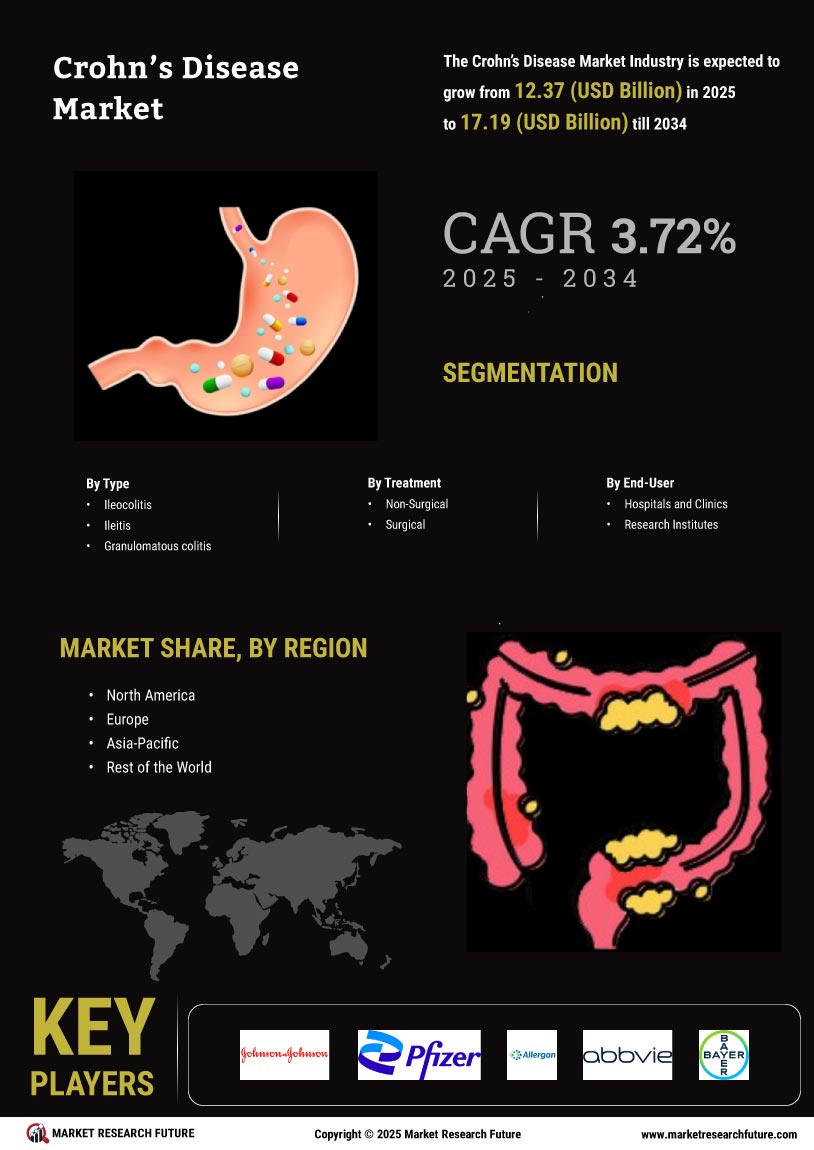Market Growth Projections
The Global Crohn's Disease Market Industry is projected to experience a compound annual growth rate (CAGR) of 3.72% from 2025 to 2035. This growth trajectory indicates a robust demand for treatment options as the prevalence of Crohn's disease continues to rise. The market is expected to reach a valuation of 17.8 USD Billion by 2035, driven by advancements in therapies, increasing healthcare expenditures, and growing awareness. These projections underscore the potential for sustained growth in the Global Crohn's Disease Market Industry, highlighting the importance of ongoing research and development efforts.
Growing Awareness and Education
There is a marked increase in awareness and education regarding Crohn's disease, which is positively impacting the Global Crohn's Disease Market Industry. Campaigns aimed at educating the public about the symptoms, risks, and management of Crohn's disease are becoming more prevalent. This heightened awareness leads to earlier diagnosis and treatment, which is crucial for effective disease management. Additionally, healthcare professionals are receiving more training on the latest treatment protocols, further enhancing patient care. As awareness continues to grow, the demand for treatment options is expected to rise, thereby propelling the Global Crohn's Disease Market Industry forward.
Advancements in Treatment Options
Innovations in treatment modalities are significantly influencing the Global Crohn's Disease Market Industry. The introduction of biologic therapies and targeted medications has transformed the management of Crohn's disease, offering patients more effective options. These advancements not only improve patient outcomes but also contribute to the market's expansion, with projections indicating a growth to 17.8 USD Billion by 2035. The ongoing research and development efforts by pharmaceutical companies are likely to yield new therapies, which may further enhance the treatment landscape. As a result, the Global Crohn's Disease Market Industry is positioned for sustained growth driven by these advancements.
Increasing Healthcare Expenditure
The Global Crohn's Disease Market Industry is benefiting from rising healthcare expenditures across various regions. Governments and private sectors are investing more in healthcare infrastructure, which includes the management of chronic diseases like Crohn's. This trend is particularly evident in developed nations, where healthcare budgets are expanding to accommodate advanced treatments and patient care. The increasing financial commitment towards healthcare is expected to facilitate better access to medications and therapies, thereby supporting the growth of the market. As healthcare spending continues to rise, the Global Crohn's Disease Market Industry is likely to experience a corresponding increase in demand for effective treatment solutions.
Rising Prevalence of Crohn's Disease
The Global Crohn's Disease Market Industry is witnessing a notable increase in the prevalence of Crohn's disease, which is a chronic inflammatory bowel disease. As of 2024, the market is valued at 11.9 USD Billion, reflecting the growing number of diagnosed cases. Factors contributing to this rise include genetic predisposition, environmental triggers, and lifestyle changes. The increasing awareness and improved diagnostic techniques further enhance the identification of this condition. Consequently, healthcare systems are compelled to allocate more resources towards treatment and management, thereby driving growth in the Global Crohn's Disease Market Industry.
Regulatory Support for Drug Approvals
The Global Crohn's Disease Market Industry is experiencing favorable regulatory environments that support the approval of new drugs and therapies. Regulatory agencies are streamlining the approval process for innovative treatments, which encourages pharmaceutical companies to invest in research and development. This supportive framework is essential for bringing new therapies to market more quickly, thereby addressing the unmet needs of patients with Crohn's disease. As more effective treatments become available, the market is likely to expand, reflecting the positive impact of regulatory support on the Global Crohn's Disease Market Industry.

















Leave a Comment